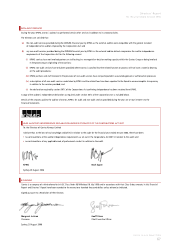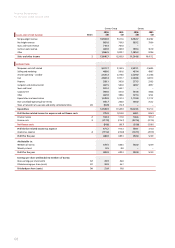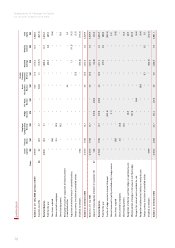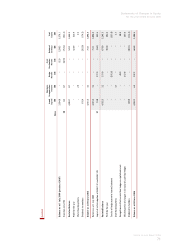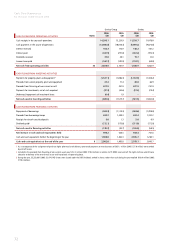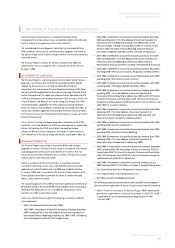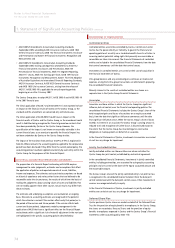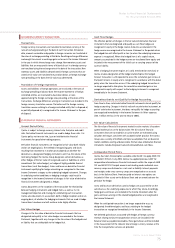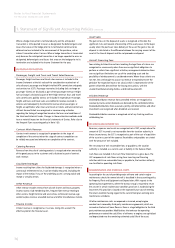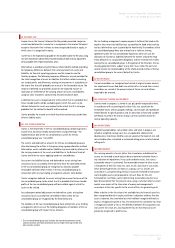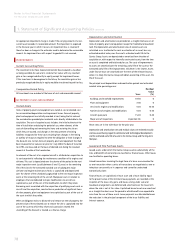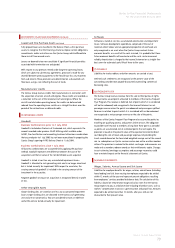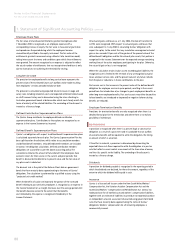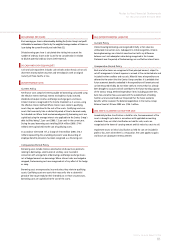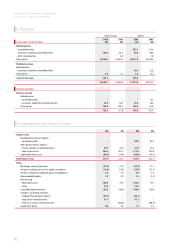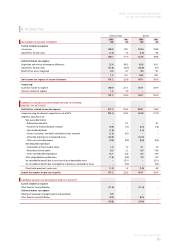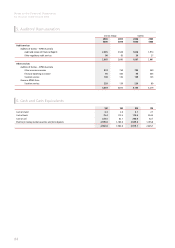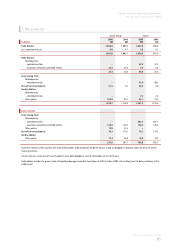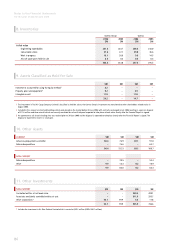Qantas 2006 Annual Report Download - page 78
Download and view the complete annual report
Please find page 78 of the 2006 Qantas annual report below. You can navigate through the pages in the report by either clicking on the pages listed below, or by using the keyword search tool below to find specific information within the annual report.
76
Notes to the Financial Statements
for the year ended 30 June 2006
Where a hedge transaction is terminated early and the anticipated
transaction is still expected to occur as designated, the deferred gains and
losses that arose on the hedge prior to its termination continue to be
deferred and are included in the measurement of the purchase, sale or
interest transaction when it occurs. When a hedge transaction is terminated
early because the anticipated transaction is no longer expected to occur as
designated, deferred gains and losses that arose on the hedge prior to its
termination are included in the Income Statement for the year.
(G) REVENUE RECOGNITION
Passenger, Freight and Tours and Travel Sales Revenue
Passenger, freight and tours and travel sales revenue is included in the
Income Statement at the fair value of the consideration received net of
sales discount, passenger and freight interline/IATA commission and goods
and services tax (GST). Passenger recoveries (including fuel surcharge on
passenger tickets) are disclosed as part of Net passenger revenue. Freight
fuel surcharge is disclosed as part of Net freight revenue. Tours and travel
sales commissions paid by Qantas are included in expenditure. Passenger,
freight and tours and travel sales are credited to revenue received in
advance and subsequently transferred to revenue when passengers or
freight are uplifted or when tours and travel air tickets and land content are
utilised. Unused tickets are recognised as revenue using estimates
regarding the timing of recognition based on the terms and conditions of
the ticket and historical trends. Changes in these estimation methods could
have a material impact on the financial statements of Qantas. Refer also to
the Frequent Flyer accounting policy in Note 1(U).
Contract Work Revenue
Contract work revenue is recognised in proportion to the stage of
completion of the contract when the stage of contract completion can
be reliably measured and otherwise on completion of the contract.
Catering Revenue
Revenue from the sale of catering products is recognised when ownership
of the goods passes to the customer and is disclosed as part of contract
work revenue.
Liquidated Damages
Income resulting from claims for liquidated damages is recognised when a
contractual entitlement exists, it can be reliably measured, (including the
impact of the receipt, if any, of the underlying assets’ carrying value) and
receipt is virtually certain.
Other Revenue
Other revenue includes revenue from aircraft charter and leases, property
income, Qantas Club membership fees, frequent fl yer revenue relating to
other carriers, freight terminal and service fees, commission revenue, age
availed surplus revenue, unavailed revenue and other miscellaneous income.
Finance Income
Interest revenue is recognised as it accrues, taking into account the
effective yield on the financial asset.
Asset Sales
The gain or loss on the disposal of assets is recognised at the date the
significant risks and rewards of ownership of the asset passes to the buyer,
usually when the purchaser takes delivery of the asset. The gain or loss on
disposal is calculated as the difference between the carrying amount of the
asset at the time of disposal and the net proceeds on disposal.
Aircraft Financing Fees
Fees relating to linked transactions involving the legal form of a lease are
recognised as revenue only when there are no significant obligations to
perform or refrain from significant activities, management determine there
are no significant limitations on use of the underlying asset and the
possibility of reimbursement is considered remote. Where these criteria are
not met, fees are brought to account as revenue or expenditure over the
period of the respective lease or on a basis which is representative of the
pattern of benefits derived from the leasing transactions, with the
unamoritised balance being held as a deferred lease benefit.
Dividend Revenue
Dividend/distribution revenue from controlled entities are recognised as
revenue by Qantas when dividends are declared by the controlled entities.
Dividends/distributions from associates, jointly controlled entities and other
investments are recognised when dividends are received.
Dividend/distribution revenue is recognised net of any franking credits or
withholding tax.
(H) GOODS AND SERVICES TAX
Revenues, expenses and assets are recognised net of GST, except where the
amount of GST incurred is not recoverable from the taxation authority. In
these circumstances, the GST is recognised as part of the cost of acquisition
of the asset or as part of the expense. Receivables and payables are stated
with the amount of GST included.
The net amount of GST recoverable from, or payable to, the taxation
authority is included as a current asset or liability in the Balance Sheet.
Cash flows are included in the Cash Flow Statement on a gross basis. The
GST components of cash flows arising from investing and financing
activities which are recoverable from, or payable to, the taxation authority
are classified as operating cash flows.
(I) MAINTENANCE AND OVERHAUL COSTS
Accounting for the cost of providing major airframe and certain engine
maintenance checks for owned aircraft is described in the accounting policy
for Property, Plant and Equipment and Depreciation. With respect to the
operating lease agreements, where the Qantas Group is required to return
the aircraft in certain maintenance condition, provision is made during the
lease term. This provision is based on the expected future cost of meeting
the return condition having regard to the current fleet plan and long-term
maintenance schedules.
All other maintenance costs are expensed as incurred, except engine
overhaul costs covered by third-party maintenance agreements, which are
accrued on the basis of hours fl own as there is a legal obligation to the third
party maintenance provider. Modifi cations that enhance the operating
performance or extend the useful lives of airframes or engines are capitalised
and depreciated over the remaining estimated useful life of the asset.
1. Statement of Signifi cant Accounting Policies continued



